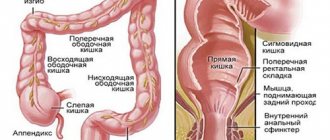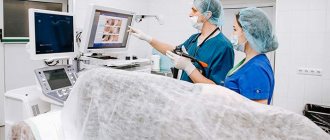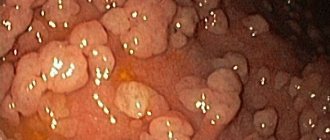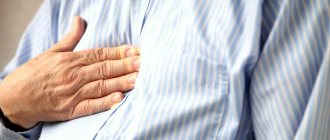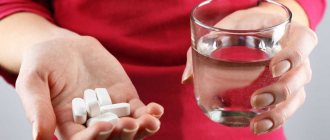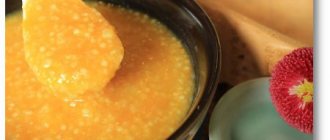There is a group of diseases that are not dangerous to the patient’s life, but significantly reduce its quality. Proctitis is one of these socially significant pathologies. Obsessive discomfort in the rectal area and a number of other symptoms of intestinal disorders arising from inflammation prevent the patient from following his usual daily routine.
To prevent this from happening, it is necessary to identify the disease in a timely manner and begin its treatment immediately. There are chronic and acute forms of rectal proctitis, each of which develops for certain reasons. Detecting them in the patient’s past can significantly facilitate diagnosis.
Classification of causes
It is customary to distinguish two groups of causes leading to inflammation of the rectum. The first is local damaging factors that directly affect the mucous membrane of this organ. The second group includes causes of a general nature that affect the entire body and, in particular, the final sections of the intestine.
Local damaging factors | Common reasons |
Rectal administration (through the anus) of any irritating substances:
Most often, they are used by patients as an alternative treatment for proctitis, which only leads to worsening symptoms. | Various infections of the intestinal tract, with a prolonged course. The development of anal proctitis can be associated not only with the entry of a microorganism into the rectal mucosa, but also with the action of mechanical factors (diarrhea, release of toxins, release of undigested food, and so on). Common infectious causes:
|
| Mechanical injury after self-massage of the anal ring, rectum or prostate. | Autoimmune diseases affecting the intestines. The most common:
|
| Incorrectly performed prostate massage. | Parasitic diseases, for example:
|
| Introduction of any foreign bodies into the rectal cavity. Proctitis can develop after treatment with enemas/microenemas or rectal suppositories. | STIs (diseases that are transmitted through sexual contact) that can affect the rectal mucosa:
|
| Transfer of infection from surrounding tissues (peri-rectal fatty tissue, bladder in men, uterus or vagina in women). | Any disturbances of motility or innervation of the colon. It can develop independently or after certain operations. The main damaging factor is chronic constipation. The most common violations:
|
| A tumor of both the rectum and surrounding tissues (with significant growth). | Radiation sickness (intestinal form), which occurs when exposed to a dose of about 10 Gray. Proctitis can also develop after radiation therapy or taking radon baths. |
It should be noted that general causes more often provoke the development of chronic proctitis. The acute form in 83% of cases is the result of exposure to a local damaging factor (with the exception of gastrointestinal infections).
Classification
Due to the occurrence
- sexually transmitted diseases, most often gonorrhea;
- radiation exposure during treatment for cervical or prostate cancer;
- gluten intolerance;
- abuse of spices, pepper, spicy foods and alcohol;
- anal sex;
- herpes;
- insufficient treatment of enemas;
- stress;
- blood stagnation due to chronic constipation;
- parasitic infestation, most often Trichomonas and dysenteric amoeba;
- hypothermia;
- inflammation or suppuration of the pouch of Douglas - the depression of the peritoneum between the uterus and rectum;
- cystitis;
- haemorrhoids;
- prostatitis in men;
- vulvovaginitis in women;
- idiopathic - the actual cause is unknown.
By activity
Depending on the activity of the process, proctitis can be acute or chronic. Acute proctitis is violent and difficult, but often ends in recovery. Chronic at first proceeds sluggishly, causes little concern, but leads to complications.
According to changes in tissues
Depending on the characteristics of changes in rectal tissue, the following forms of proctitis are distinguished:
- catarrhal-hemorrhagic - the mucous membrane turns red, pinpoint hemorrhages are visible on it;
- catarrhal-purulent - the mucous membrane is inflamed, the surface is covered with pus;
- catarrhal mucous – there are signs of inflammation of the mucous membrane, on the surface of which there is a lot of mucus;
- polypous - polyps or submucosal tissue growth form on the altered mucosa;
- erosive - a condition preceding the formation of ulcers;
- ulcerative, in which the formation of ulcerative defects does not extend beyond the rectum and sigmoid colon.
Be sure to read: Why is there a burning and itching in the anus and how to treat the pathology?
Symptoms of acute proctitis
As a rule, signs of the acute form appear immediately or several hours after the action of the damaging factor (with the exception of tumors). Patients are concerned about two main symptoms:
- The pain is of a pulling nature, of medium or low intensity, which intensifies during bowel movements. Patients often cannot name the exact location of the pain and point to the lower abdomen or lower back. However, upon active questioning, it turns out that the unpleasant sensations are located in the area of the sacrum or anus. They do not go away during the day, which leads to anxiety and increased irritability of the patient. The pain syndrome decreases somewhat after taking anti-inflammatory drugs (Ketorolac, Ibuprofen, Nimesulide) or combination drugs (Baralgin, Spazmalgon);
- Violation of the act of defecation - the patient constantly “pulls to go to the toilet” (false urge). Due to the frequency of defecation, the stool becomes mucous in nature; only mucus (a small amount) mixed with blood can be released. Constipation may develop due to a psychological block - the patient is afraid to go to the toilet, as this provokes increased pain.
Symptoms of acute proctitis can be supplemented by a decrease in appetite, a short-term increase in temperature (no more than 37.6 ° C), and discomfort in the abdominal area (due to impaired motor skills).
Symptoms of chronic proctitis
In this form, exacerbations alternate with periods of remission. The main criterion for diagnosis is the course of the disease for more than 6 months.
The clinical picture without an exacerbation is erased - most often, it is limited to a periodic feeling of discomfort in the rectum. Since chronic proctitis often occurs against the background of another disease, the symptoms associated with this pathology come to the fore for the patient.
Symptoms and treatment of proctitis during an exacerbation are similar to the acute form.
Treatment of proctitis with folk remedies
Treatment of proctitis with folk remedies helps eliminate all symptoms of inflammation of the rectal mucosa.
The use of enemas, infusions of medicinal plants, ointments allows you to get rid of pain, burning, itching, and dyspeptic disorders. Folk remedies include beekeeping products, oils, and mumiyo.
They often contain propolis, decoctions of roots, flowers, herbs and other useful ingredients.
The therapeutic effectiveness of baths and enemas is quite high, but only if the procedures are carried out correctly at home. Let's consider some features of the preparation of ointments and infusions that should definitely be taken into account.
Signs of proctitis and why it is dangerous
Acute, subacute and chronic proctitis is manifested by pain in the rectal area and defecation disorders. Its specific symptoms include a false urge to have a bowel movement.
The following symptoms are characteristic of proctitis::
- the appearance of drops of fresh blood or dark blood clots in the stool;
- diarrhea with copious mucus discharge;
- increased pain during bowel movements.
If left untreated, complications develop : bleeding from the rectum, perforation of the intestinal wall, formation of a fistula or stricture. In especially severe cases, incontinence of intestinal contents is observed.
Attention! With chronic proctitis, iron deficiency anemia occurs. The skin becomes gray, dry, hair falls out greatly, and nails become thinner.
How to treat at home
An important condition for effective treatment of proctitis with folk remedies is a preliminary medical examination . The reasons for the development of this disease can be varied.
In case of helminthic infestation, the use of anthelmintics (tansy infusion) is required, and in case of radiation damage, regeneration stimulants (sea buckthorn oil) cannot be avoided.
Enemas
A therapeutic enema is a procedure that involves injecting a medicinal solution into the rectum . In folk medicine, the following remedies are used for this purpose:
- decoctions and infusions of plants;
- warm vegetable oils.
They have pronounced anti-inflammatory, analgesic and anti-edematous properties . After 2-3 procedures, the mucous membrane begins to recover.
Herbal infusions and decoctions
In folk medicine, infusions, decoctions and tinctures are used both topically and orally to treat proctitis .
The chemical composition of medicinal plants is saturated with bioactive substances:
- flavonoids;
- mucus;
- saponins;
- water- and fat-soluble vitamins;
- micro- and macroelements.
The use of infusions and decoctions helps accelerate metabolism and regenerate the rectal mucosa damaged by inflammation. Local immunity is also strengthened, reducing the risk of relapses.
Ointments and oils
These are the most effective folk remedies. Ointments contain ingredients with diverse effects :
- anti-inflammatory;
- decongestant;
- painkillers;
- astringent;
- antipruritic.
Oils envelop the mucous membrane, protecting it from further damage . The resulting film prevents pathogenic bacteria and fungi from penetrating microcracks.
Traditional recipes and application schemes
When preparing folk remedies and using them, you should strictly follow the instructions . Dosages should not be exceeded in hopes of speeding up recovery. Many components have a cumulative effect, providing a prolonged (long-lasting) effect. Therefore, it is not advisable to take breaks in treatment or end it prematurely.
Important! The most pronounced therapeutic properties are those made from plants that are sold in pharmacies. Such herbs, flowers and roots are properly collected, dried and crushed.
Therapeutic enemas
Daily evening enemas will allow you to cure proctitis. Before the procedure, you need to empty your bowels naturally or with the help of mild laxatives.
The following folk remedies give the best results::
- Chamomile infusion: 2 tbsp. Pour a glass of boiling water over spoons of dry plant material, leave for an hour, strain.
- Infusion of succession: 1 tbsp. pour a spoonful of dry herbs into a glass of boiling water, filter after two hours.
- Vegetable oils: heat olive, sunflower, corn or flaxseed oil to 50°C. The enema is filled with 200 ml of medicinal fluid and injected into the rectum once a day for 1-2 weeks. This is convenient to do while lying on your side with your knees pulled up to your chest.
Infusions and decoctions
It is not difficult to prepare infusions and decoctions at home. They can be either single-component or contain several medicinal herbs.
The following folk remedies have proven themselves particularly well in the treatment of proctitis :
- Vitamin decoction: pour a handful of rose hips, juniper, barberries into a saucepan, pour in 2 liters of boiling water, simmer for 15 minutes, cool, strain, drink a glass twice a day after meals.
- Regenerating infusion: put 1 tbsp in a thermos. spoon of bearberry, birch leaves and buds, pour in 3 cups of boiling water, leave for an hour, cool, filter, drink 1/2 cup during lunch and dinner. It is also useful to drink a soothing infusion. To prepare it, pour 1 teaspoon of motherwort with a glass of boiling water, and strain after an hour.
Reference. Infusions and decoctions must be stored in a cool place, protected from sunlight. The shelf life of folk remedies is three days.
Symptoms of radiation proctitis
Radiation proctitis is a chronic form of the disease, but clinicians distinguish it as a separate type. The main difference is the pronounced, “excruciating” pain syndrome that constantly accompanies the patient. Unfortunately, no effective pain relief for radiation proctitis has been developed, so it is extremely difficult to reduce its symptoms.
In addition to local manifestations, the pathology is accompanied by a number of other symptoms:
- weight loss;
- decreased/lack of appetite;
- immunosuppression, which makes a person susceptible to the development of respiratory and intestinal diseases.
The clinical picture is not limited to this, since radiation sickness also affects a number of other organs.
Diagnostics
To correctly diagnose proctitis, it is necessary to conduct a comprehensive examination. It should begin with a routine examination of the anal and perianal areas.
What can be found during inspection
In acute proctitis (or with exacerbation of the chronic form), the following changes are observed:
- redness of the skin around the anus (perianal area);
- openings of fistula canals may appear. They appear in the form of small “protrusions” of the skin, painful to the touch, from which pus or blood is released;
- the wall of the anal canal is rich red. Sometimes, cracks can be detected with the naked eye.
In children, injuries to the anus often bleed, which makes it possible to suspect acute proctitis. With long-term proctitis in adults, hemorrhoidal nodules are often found, which look like limited thickenings of a dark color. When examined, they may protrude from the rectal cavity or be located within it
Inspection technique
The patient should be in the knee-elbow position in order to have optimal visual access. To examine the anal ring and the final parts of the rectum, it is necessary for the patient to relax as much as possible. For a more thorough examination, an anoscope (a specialized device for proctological examination) is used.
Carrying out a digital examination
This is one of the oldest diagnostic methods that does not require special tools. With its help, the doctor is able to suspect not only the presence of inflammation of the rectum, but also the possible cause of proctitis (tumor, foreign object, mechanical injury).
No preparation is required from the patient. The optimal position for the study is knee-elbow. If the patient's condition does not allow him to take this position, a position on the left side with the legs brought to the stomach is recommended.
During the examination, the doctor evaluates:
- the integrity of the rectum and the condition of its walls;
- the presence of any formations on the wall (tumor, fistula, abscess);
- the nature of the discharge (which remains on the glove).
Before the procedure, the doctor must lubricate the glove with liquid petroleum jelly, so the digital examination is painless for the patient.
Instrumental methods
The optimal way to diagnose this disease is an instrumental examination. The diagnosis of proctitis cannot be made if the patient has not been examined by a proctologist. Currently, the following methods are used:
- anoscopy - carried out using a proctological (rectal) mirror, which is lubricated with petroleum jelly and inserted into the anus, slightly expanding it. This tool provides a better view than a normal inspection. It does not require special preparation of the patient. It is carried out in the same positions as the digital examination.
- sigmoidoscopy is an endoscopic method during which a detailed examination of the walls of the rectum (up to 30 cm) is carried out. To do this, use a sigmoidoscope - an elastic tube with a camera and a light source, which is inserted through the anus. By analyzing changes in the mucous membrane, they can determine the form of the disease: catarrhal proctitis - most often occurs after the action of irritating substances on the rectum. Characterized by the appearance of pronounced edema and increased “vascular pattern”;
- purulent proctitis - the presence of pus in the rectal cavity and infiltration of the wall with immune cells (leukocytes) indicates this form. Develops due to the action of microorganisms;
- erosive proctitis - with this form, thinning of the surface layer of the intestine occurs, which is often observed with a long-term process;
- ulcerative proctitis - characterized by the formation of deep defects with damage to the muscle layer. Is a sign of UC;
- mixed forms - arise from a combination of various pathogenic factors.
The form does not have a significant impact on treatment tactics, but helps to suggest the cause of the development of proctitis.
How to prepare for sigmoidoscopy
It is necessary to completely clear the rectum of feces so that nothing interferes with the examination. Preparation includes the following steps:
- 3 days before the study, a diet is recommended that excludes foods rich in fiber (any vegetables, berries, fruits; rye bread; corn and pearl barley, and so on);
- In the evening, on the eve of sigmoidoscopy, the patient can eat a light dinner (not containing the above products);
- After 50 minutes, the patient begins to receive enemas every hour until the rinsing waters are “clean”;
- Sigmoidoscopy is performed on an empty stomach, so the patient is not recommended to have breakfast;
- In the morning, enemas are given again until “clean” rinsing water is obtained;
- Immediately before sigmoidoscopy, a digital examination is performed to prepare the anus for the advancement of the endoscope and reduce the risk of injury.
Biopsy
This term refers to the removal of rectal tissue for examination under a microscope. The biopsy is performed during sigmoidoscopy using endoscopic forceps. Local anesthesia is not indicated for this procedure, so it is somewhat unpleasant for the patient. However, a biopsy is necessary to rule out the presence of a tumor on the rectal wall.
Laboratory diagnostics (general blood, urine and stool tests) can be used as additional methods. However, they are informative only in the presence of chronic proctitis, to identify the underlying disease.
Treatment of acute proctitis
A combination of non-drug therapy along with medication is important. The first point implies limiting significant physical activity; bed rest is desirable. The patient is strongly recommended to follow a gentle diet until all symptoms of proctitis disappear. It implies an exception:
- mechanically irritating dishes and drinks (too hot/cold; optimal temperature 15-20°C);
- chemically irritating dishes (sour, salty, bitter, fried, etc.);
- products that can provoke the development of constipation and impaired motor skills (pomegranate, flour dishes, pasta).
It is important that meals are regular and fractional (small portions). You should not take long breaks between meals (more than 6 hours), as this can lead to disruption of the passage of the food bolus through the intestines.
In addition to diet, non-drug treatment of proctitis includes local anti-inflammatory procedures, such as:
- baths with potassium permanganate (potassium permanganate). They are recommended to be taken in a sitting position, no more than 4 times a day;
- enemas/finger application of sea buckthorn or olive oils to the walls of the rectum;
- To improve the general condition, mild sedative (calming) drugs are recommended - tinctures of valerian/motherwort. They can be used up to 4 times a day, dissolving 30-40 drops of tincture in 100 ml of water.
Drug therapy depends on the cause of acute proctitis. Here are the most common treatment regimens:
When irritating substances are introduced into the intestine or after mechanical trauma (minor)
| Group of drugs + examples | What are they doing? | How to use? |
NSAIDs (non-hormonal anti-inflammatory drugs):
An alternative is combination drugs (antispasmodics + NSAIDs):
|
| Tablets orally (after meals) or intramuscular injections. No more than 4 times a day. For long-term use (more than a week), it is recommended to take these drugs together with PPIs (“proton pump inhibitors”). This will prevent such side effects as the development of peptic ulcers. Drugs: Omeprazole, OMEZ, Rabeprazole and so on. |
Local glucocorticosteroids (hormones):
|
| Only in the form of rectal suppositories or ointments. It is recommended to apply/inject into the rectum 4 times a day. |
Laxatives (weak):
| To prevent constipation, as it can aggravate symptoms | Tablets for oral administration, 1 time per day. Guttasil and Guttalax are recommended to be taken before bed, as stool relief occurs only after 12 hours. |
For infectious inflammation of the rectum
First of all, it is necessary to eliminate the damaging factor - to destroy harmful bacteria in the rectal cavity. It should be noted that if the occurrence of proctitis is associated with intestinal infections (escherichiosis, dysentery, etc.), it is necessary to use drugs to sanitize the entire intestine.
Hormones (glucocorticosteroids) for topical use are not recommended for infectious inflammation, as they can promote the spread of bacteria and prevent their destruction.
The treatment regimen that can be used for infectious proctitis is as follows:
- Local antiseptic suppositories and ointments that are aimed at destroying bacteria. For example: Proctosan, Simetride;
How to use? It is recommended to administer the drug after defecation, twice a day. If you purchased the medicine in ointment form, it should only be administered using the applicator (which is included in the kit). After administering the ointment or rectal suppository, the drug should be kept in the intestinal cavity for at least 30 minutes. There is no need to specifically remove it. After the symptoms disappear, it is recommended to continue the course for another 7-9 days.
- Antibacterial drugs to sanitize the intestines from bacteria (only for intestinal infections). The best of them is Furazolidone - having a wide spectrum of action, it reaches its maximum concentration in the intestinal cavity and is absorbed into the blood by only 30%. Unfortunately, patients are often allergic to it. In this case, an alternative is antibiotics - Tetracyclines (Unidox, Doxycycline). They are contraindicated for pregnant women and children under 8 years of age. The safest poison for them is Josamycin, but only a doctor can choose the optimal antibiotic during an individual consultation.
How to restore normal bowel function? Since these drugs specifically destroy the intestinal microflora (both pathogenic and normal), after completing the course, problems with digesting food (especially dairy and plant products) may arise. To prevent this, you should “settle” beneficial bacteria with the help of medications such as Bifidum, Bifidumbacterin, Linex, etc. (see list of probiotics).
- NSAIDs/combined drugs (antispasmodics + NSAIDs);
- Laxatives (described above).
As a rule, the symptoms of infectious intestinal inflammation disappear within a few days (up to a week) if treatment was correctly prescribed and started in a timely manner.
With the introduction of a foreign body or inflammation of the peri-rectal tissue
Surgical intervention is indicated - removal of a foreign body from the intestinal cavity or a purulent focus in the tissue. After the operation, the surgeon determines further therapy, depending on the presence of complications, the degree of damage to the rectum and the patient’s condition. As a rule, it includes:
- Antibiotic;
- NSAIDs;
- Laxative.
Clinical fact. The human intestine is capable of not only performing peristalsis towards the rectum, but also moving objects in the opposite direction (if it is completely blocked). Therefore, foreign objects that patients insert into their rectum often end up much higher - in the sigmoid or even colon (30-50 cm higher). In this case, the surgeon cannot remove the object without making incisions, which is why he has to perform more traumatic operations.
For rectal tumors
In this case, the patient is sent for consultation to an oncologist. A repeat biopsy is performed and, if possible, a CT scan. Thanks to this, the extent of tumor spread, the presence of metastases and damage to the lymph nodes are determined. If the tumor is benign, only the tumor is removed. In case of a malignant tumor that has not had time to grow into neighboring organs and give metastases, the entire rectum is removed with a sigmostoma (extending the external opening of the intestine to the anterior abdominal wall). If the malignant tumor has spread beyond the rectum, radiation and chemotherapy are used.
A very approximate scheme of the oncologist’s actions is described, since the treatment of rectal tumors (especially cancer) is a complex step-by-step process that only a specialist can correctly carry out. Read more about treatment for colorectal cancer.
Treatment
Treatment is complex and includes diet, medication, and local procedures. In the acute period, bed rest is required. Purulent, erosive, polypous and ulcerative forms of proctitis must be treated in a hospital. The rest can be treated on an outpatient basis.
Diet
Food should not irritate or injure the inflamed mucous membrane. A gentle diet is the basis of recovery; without it, treatment does not help much.
| Recommended Products | Not Recommended Products |
|
|
It is recommended to eat small meals up to 6 times a day with short breaks of 3 or 4 hours. The serving size is small, about a glass.
Drugs
Several groups are used:
- Antibiotics. Prescribed in accordance with the results of bacteriological stool culture. The most commonly used are fluoroquinolones, in particular Ciprofloxacin, Tsiprolet, as well as macrolides – Clarithromycin and others. There may be other combinations, it all depends on the specific microflora that caused proctitis.
- Sulfonamides - Biseptol or Co-trimoxazole, Phthalazole. Medicines act exclusively in the intestinal lumen and disrupt the synthesis of microbial cells.
- Corticosteroid hormones for ulcerative form - Prednisolone, Triamcinolone, Polcortolone and others.
- Rectal suppositories - used only as prescribed by a doctor; independent use can worsen the course of the disease. It is possible to use suppositories with sea buckthorn, propolis, Ultraproct, Relief and others.
- Other drugs according to indications - antipyretic, immune-strengthening, detoxification, vitamin-mineral complexes.
For any course of proctitis, local treatment is important. To speed up the subsidence of inflammation, microenemas with chamomile decoction or collargol are used. Collargol is an antiseptic with colloidal silver, which has an additional astringent effect.
After inflammation subsides, warm oil enemas, sitz baths with a weak solution of potassium permanganate, irrigation of the perineum with warm water, and a shower on the perineum are useful.
Be sure to read:
Rectal cancer: symptoms, stages, treatment and prognosis for life
During the period of remission, sanatorium-resort treatment is useful, during which therapeutic mud is used on the pelvic area, intestinal lavage with alkaline mineral waters.
Folk remedies
If you have proctitis, you should not use laxatives, as they irritate the mucous membrane.
For constipation, decoctions of flax seed or plantain are recommended. Steamed seeds form mucus, which envelops the intestines and improves the movement of feces.
Traditional medicine recommends homemade suppositories made from grated potatoes during the period when inflammation subsides, which speed up recovery.
Read more: Herbs and their use for intestinal inflammation
Surgery
Long-term chronic proctitis leads to the formation of rough scars that cause narrowing of the rectum. These cases are treated only surgically.
Treatment of chronic proctitis
In this form, all the doctor’s efforts are aimed at detecting and eliminating the manifestations of the underlying disease (due to which inflammation of the rectum has developed). Its successful therapy is the only way to get rid of chronic proctitis. Treatment regimens for possible causes are very complex, so we will describe only the fundamental points:
Cause of chronic proctitis | Basis of treatment |
| Autoimmune diseases |
|
| STI | Specific antibiotic therapy in combination with anti-inflammatory drugs. |
| Parasitic diseases |
|
| Irritable bowel syndrome | Elimination of increased excitability with the help of sedative (calming) drugs. It is important to carry out therapy in combination with lifestyle correction. |
Reasons for the development of the disease
Often proctitis is one of the manifestations of inflammatory diseases of the colon: ulcerative colitis, Crohn's disease or dysentery.
Inflammation of the rectum can develop in patients who have undergone surgery on the rectum, for example, for hemorrhoids, anal fissures, or paraproctitis.
Proctitis can occur in patients with acute intestinal infections caused by campylobacter, chlamydia, herpes viruses and cytomegalovirus.
The cause of proctitis can also be pathogens of sexually transmitted diseases: gonorrhea and syphilis.
Inflammation of the rectal mucosa is sometimes caused by treatment with antibiotics, radiation therapy, and the use of enemas with irritating substances.
